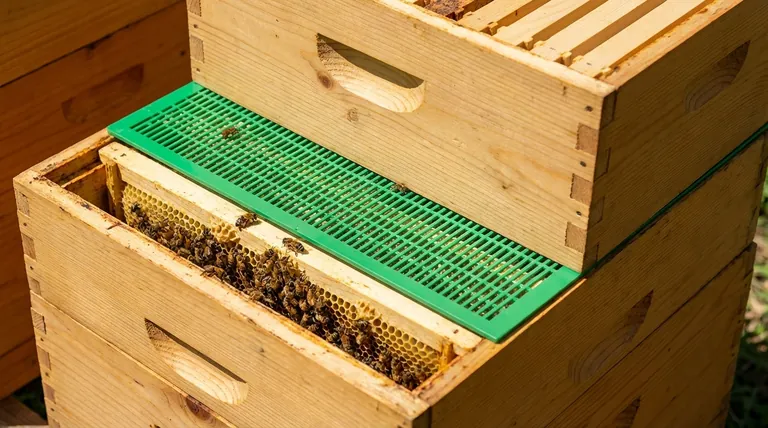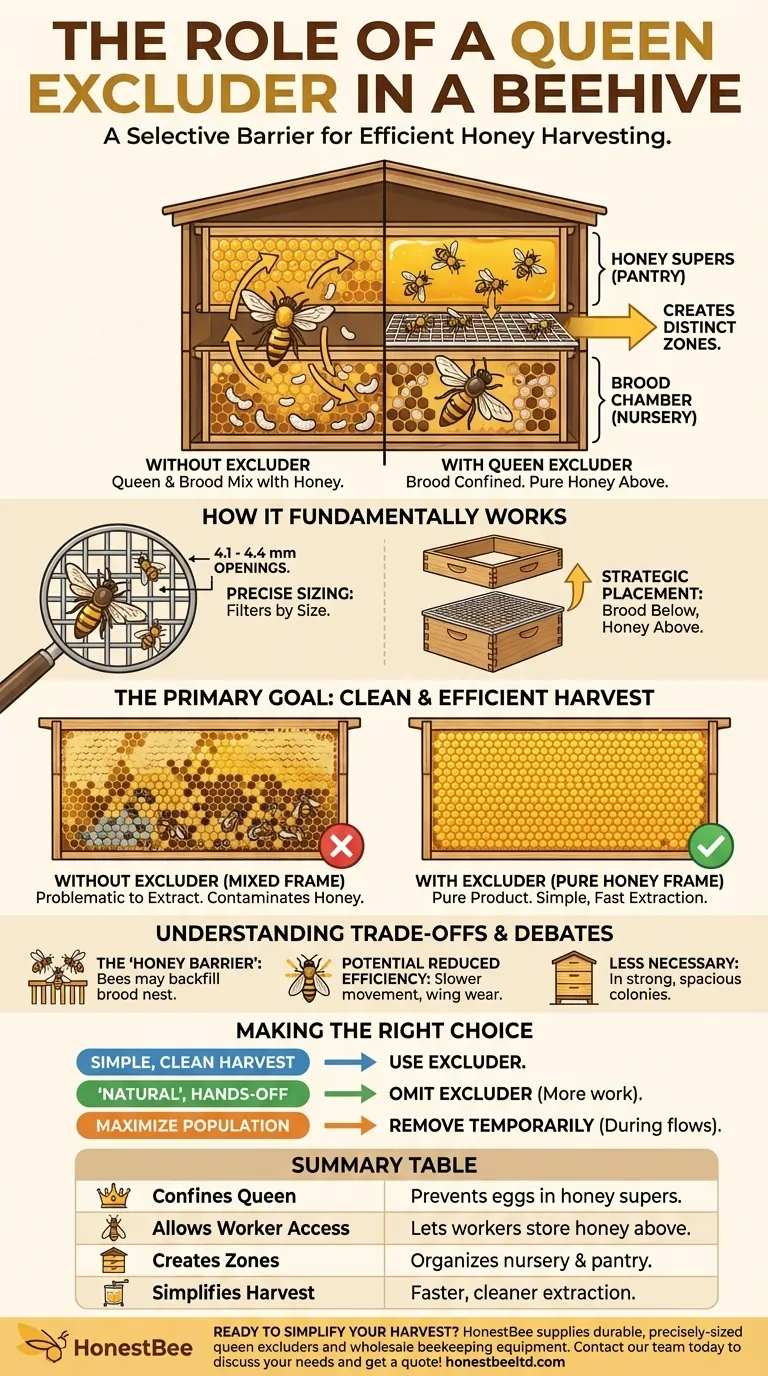At its core, a queen excluder is a selective barrier inside the beehive. Its primary role is to control the queen's movement, keeping her and her eggs confined to the lower sections of the hive (the brood chamber) while allowing smaller worker bees to pass through to the upper sections (the honey supers). This ensures a clean separation between the colony's "nursery" and its "pantry."
The fundamental purpose of a queen excluder is to simplify honey harvesting. By preventing the queen from laying eggs in the honey supers, you ensure those frames contain only pure honey, making the extraction process cleaner, faster, and more efficient.

How a Queen Excluder Fundamentally Works
A queen excluder is a remarkably simple device that leverages a basic biological fact: the queen bee is physically larger than her worker bees.
A Matter of Precise Sizing
The excluder is a flat grid, typically made of metal or plastic, with openings that are precisely sized. These gaps, usually between 4.1 and 4.4 millimeters, are wide enough for worker bees to move through freely but too narrow for the larger queen and male drones to pass.
This creates a one-way filter for the largest members of the colony, effectively creating distinct zones within the hive.
Strategic Placement for Control
The excluder is placed directly on top of the brood chamber—the box or boxes where the queen lays her eggs and the colony raises its young. The honey supers, where you want bees to store surplus honey, are then placed on top of the excluder.
This setup forces a specific organization on the hive: brood-rearing happens below the excluder, and mass honey storage happens above it.
The Primary Goal: A Clean and Efficient Honey Harvest
While it may seem like a minor intervention, using an excluder has a significant impact on the beekeeper's workflow. Without it, the hive operates without internal barriers.
Separating the Nursery from the Pantry
A queen naturally seeks empty cells to lay eggs in. Without an excluder, she is free to move up into the honey supers and lay eggs in a scattered pattern amongst the cells being filled with nectar.
This creates frames that are a mix of honey, nectar, pollen, and brood (eggs, larvae, and pupae).
Why Brood in Honey Is a Problem
Harvesting honey from frames that contain brood is highly problematic. The process of uncapping and spinning the frames in an extractor would destroy the developing bees and contaminate the honey.
Beekeepers would have to carefully cut out sections of pure honey, a time-consuming and inefficient process that yields less honey and damages the comb.
Ensuring a Pure Product
By restricting the queen, the excluder guarantees that frames in the honey super contain only one thing: honey. This makes the entire harvest process incredibly straightforward. The beekeeper can remove entire frames, uncap them, and extract pure, high-quality honey with minimal effort.
Understanding the Trade-offs and Debates
The use of a queen excluder is a subject of ongoing debate among beekeepers. It is a tool of control, and that control comes with potential downsides.
The "Honey Barrier" Effect
Some beekeepers observe that worker bees can be hesitant to pass through the excluder, treating it as a ceiling. This can sometimes lead to a "honey barrier," where bees backfill the brood chamber with nectar instead of moving up into the empty supers, potentially limiting the honey crop and increasing the chance of the hive swarming.
Potential for Reduced Efficiency
Even when bees do pass through, they must squeeze through the grid. Some argue that the sharp edges on metal excluders can damage workers' wings over time and that the extra effort slows down the rate of honey deposition. This has led to the term "honey excluder" being used by its critics.
When an Excluder Is Less Necessary
In very strong colonies with ample space—for example, a hive with two deep brood boxes—the queen has plenty of room to lay. She will naturally tend to stay in the lower part of the hive where the brood nest is concentrated. In these cases, many beekeepers find an excluder unnecessary, as the queen rarely ventures into the top supers anyway.
Making the Right Choice for Your Goal
Deciding whether to use a queen excluder depends entirely on your management style, the configuration of your hive, and your primary objective.
- If your primary focus is a simple, clean honey harvest: Use a queen excluder. It is the most reliable way to guarantee brood-free honey supers and simplify your workflow.
- If your primary focus is a more "natural" or hands-off approach: You might choose to omit the excluder, especially in a tall hive with plenty of brood space, and accept the need for more careful frame selection during harvest.
- If your primary focus is maximizing population in a strong hive: Some experienced beekeepers remove the excluder during a major nectar flow to encourage the bees to fill the supers as quickly as possible, accepting the risk of some brood appearing in the lower honey super.
Ultimately, the queen excluder is a strategic tool, and understanding its purpose and its trade-offs empowers you to manage your hives effectively.
Summary Table:
| Key Function | Benefit for Beekeeper |
|---|---|
| Confines the Queen | Prevents eggs in honey supers, ensuring pure honey. |
| Allows Worker Access | Lets worker bees pass freely to store honey above. |
| Creates Hive Zones | Organizes the hive into a brood chamber and honey supers. |
| Simplifies Harvest | Makes extraction faster, cleaner, and more efficient. |
Ready to simplify your honey harvest with reliable equipment?
As HONESTBEE, we supply durable, precisely-sized queen excluders and other essential beekeeping supplies to commercial apiaries and distributors. Our wholesale-focused operations ensure you get the high-quality equipment you need to maximize efficiency and protect your honey crop.
Contact our team today to discuss your needs and get a quote!
Visual Guide

Related Products
- High Performance Plastic Queen Excluder for Beekeeping and Apiary Management
- Professional Plastic Queen Excluder for Modern Beekeeping
- Wooden Queen Bee Excluder for Beekeeping
- HONESTBEE 6 Frame Three Use Electric Honey Extractor for Beekeeping
- Metal Queen Bee Excluder for Beekeeping
People Also Ask
- What are the benefits of a queen excluder? Ensure Pure Honey & Simplify Hive Management
- How does a queen excluder affect honey storage? Maximize Clean Honey Yields in Your Hive
- What materials are modern queen excluders made from? Choose the Right Material for Your Apiary
- When is the typical time frame for harvesting honey and removing the queen excluder? Optimize Your Hive Management
- When should I remove my queen excluder? Timing is Critical for Winter Bee Survival



















